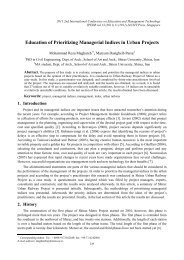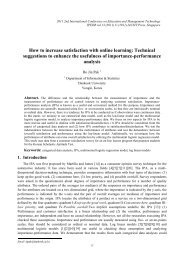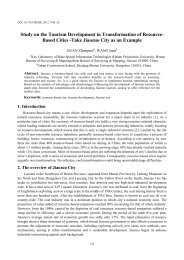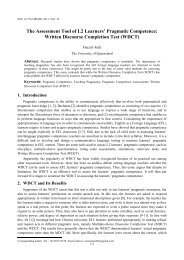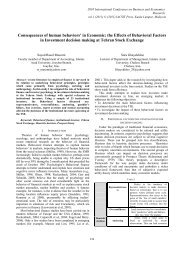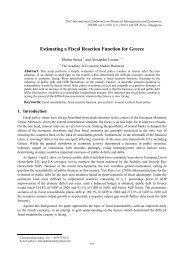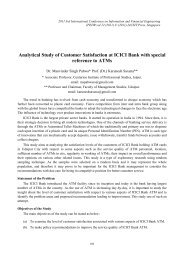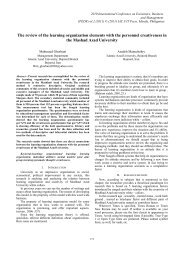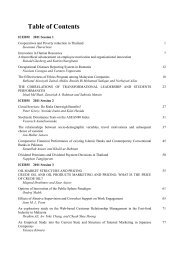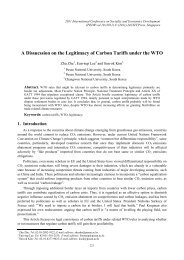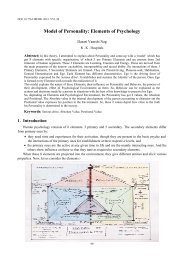Examining acceptance of information technology: A ... - ipedr
Examining acceptance of information technology: A ... - ipedr
Examining acceptance of information technology: A ... - ipedr
Create successful ePaper yourself
Turn your PDF publications into a flip-book with our unique Google optimized e-Paper software.
2011 3rd International Conference on Information and Financial Engineering<br />
IPEDR vol.12 (2011) © (2011) IACSIT Press, Singapore<br />
<strong>Examining</strong> <strong>acceptance</strong> <strong>of</strong> <strong>information</strong> <strong>technology</strong>: A longitudinal<br />
Study <strong>of</strong> Iranian high school teachers<br />
Atefeh Ataran 1 , Kolsum Nami 2<br />
1 M.A. student <strong>of</strong> Adult Education <strong>of</strong> University <strong>of</strong> Tehran<br />
2 M.A. student <strong>of</strong> Educational Management <strong>of</strong> University <strong>of</strong> Tehran<br />
Abstract. There is a growing recognition <strong>of</strong> the significance <strong>of</strong> <strong>information</strong> <strong>technology</strong> in education.<br />
However, resistance to the <strong>acceptance</strong> <strong>of</strong> <strong>technology</strong> by public school teachers’ worldwide remains high and<br />
also fostering <strong>technology</strong> <strong>acceptance</strong> among individual educators remains a critical challenge for school<br />
administrators’ <strong>technology</strong> advocates, and relevant government agencies. It is therefore <strong>of</strong> great importance<br />
to understand how and when teachers use computer <strong>technology</strong> in order to devise implementation strategies<br />
to encourage them This study examined the factors that influenced public school teachers’ <strong>technology</strong><br />
<strong>acceptance</strong> decision making by using a research model that is based on the key findings from relevant prior<br />
research and important characteristics <strong>of</strong> the targeted user <strong>acceptance</strong> phenomenon .This research model<br />
employs the current TAM as a basis and extends it by adding job relevance, education and subjective norm as<br />
external variables. The model was longitudinally tested using responses from more than 200 teachers<br />
attending an intensive 4-week training program on Micros<strong>of</strong>t PowerPoint, a common but important<br />
classroom presentation <strong>technology</strong>. The analysis <strong>of</strong> the collected data at the beginning and the end <strong>of</strong> the<br />
training supports most <strong>of</strong> our hypotheses and sheds light on the plausible changes in their influences over<br />
time. Results <strong>of</strong> the study are consistent with the TAM factors for explaining behavioral intention. The study<br />
also indicates that the job relevance and education have substantial influence on the teachers’ <strong>technology</strong><br />
<strong>acceptance</strong>. Theoretical and practical implications <strong>of</strong> the obtained results are discussed within the context <strong>of</strong><br />
the education.<br />
Keywords: adoption <strong>of</strong> <strong>information</strong> <strong>technology</strong>, teacher education, <strong>technology</strong> <strong>acceptance</strong> model,<br />
Structural equation modelling, IT adoption in education<br />
1 University <strong>of</strong> Tehran, Educational sciences department, Tehran, Iran. Tel.: +989356054760.<br />
E-mail address: Atefeh.Ataran@yahoo.com<br />
2 University <strong>of</strong> Tehran, Educational sciences department, Tehran, Iran. Tel.: +989179471159.<br />
E-mail address: Kolsum.Nami@yahoo.com<br />
190
1. Introduction<br />
Recent advances, especially in the area <strong>of</strong> computer <strong>technology</strong>, have heralded the development and<br />
implementation <strong>of</strong> new and innovative teaching strategies. Research has shown that teachers’ perceptions<br />
and attitudes towards technologies influenced the effective use <strong>of</strong> these technologies in teaching and learning<br />
(Paraskeva; Bouta; & Papagianna, 2008). It is important for teachers to understand the precise role <strong>of</strong><br />
<strong>technology</strong> in teaching and learning so that they can learn to cope effectively with the pressure created by the<br />
continual innovation in educational <strong>technology</strong> and constant need to prioritize the use <strong>of</strong> <strong>technology</strong> (Zhao,<br />
Hueyshan, & Mishra, 2001). Therefore, due to the importance <strong>of</strong> <strong>technology</strong> in education, pervasive<br />
<strong>technology</strong> <strong>acceptance</strong> by school teachers is required for realizing the <strong>technology</strong>-empowered<br />
teaching/learning paradigm advocated by visionary educators and IT pr<strong>of</strong>essionals. However, resistance to<br />
the <strong>acceptance</strong> <strong>of</strong> <strong>technology</strong> by public school teachers worldwide remains high (Hwa-Hu; Clark; & Ma,<br />
2003). In order to predict, explain and enhance <strong>technology</strong> <strong>acceptance</strong> and correspondingly increase<br />
utilization, Davis (1986) presented the original model <strong>of</strong> <strong>technology</strong> <strong>acceptance</strong> model (TAM) (Lee; Li; Yen;<br />
& Huang, 2010). The key purpose <strong>of</strong> TAM is to trace the impact <strong>of</strong> external variables on internal beliefs,<br />
attitudes, and intentions (Afari-Kumah; Achampong, 2010). Although the TAM has been extensively tested<br />
and validated among users in the business world, its application in education is limited. A possible reason for<br />
the relatively limited applications <strong>of</strong> the TAM in educational settings may be explained by the ways teachers<br />
interact with <strong>technology</strong>, compared to <strong>technology</strong> users in the business settings (Teo; B. Lee; Chai; Wong,<br />
2009).This study examined the factors that influenced high school teachers’ <strong>technology</strong> <strong>acceptance</strong> decision<br />
making by using a research model. The model was longitudinally tested by Iranian teachers attending an 4-<br />
week training program on Micros<strong>of</strong>t PowerPoint, which can greatly facilitate teachers’ organizing, archiving,<br />
presenting, updating and sharing class materials (Alavi; Yoo; Vogel, 1997).<br />
2. Research model and hypotheses<br />
This research employs a model based on the current TAM (Davis ; Bagozzi; Warshaw, 1985) as a basis<br />
and tries to obtain a broader view <strong>of</strong> issues related to <strong>technology</strong> <strong>acceptance</strong> than has been included in<br />
previous research projects. This broader view included consideration <strong>of</strong> additional external factors such as<br />
job relevance, subjective norm and education as shown in figure1.<br />
Perceived usefulness and perceived ease <strong>of</strong> use<br />
Perceived usefulness (PU) is considered to be an extrinsic motivation for the user, and is defined as the<br />
degree to which a person believes that the use <strong>of</strong> a particular system can enhance work performance (Arteaga<br />
Sánchez,& A. Duarte Hueros ,2010). Perceived ease <strong>of</strong> use (PEOU) is the degree to which a person believes<br />
that using a particular system would be free <strong>of</strong> effort. A recent review found that these two variables received<br />
considerable attention in a great number <strong>of</strong> prior computer <strong>technology</strong> <strong>acceptance</strong> studies and were<br />
significant in both direct (PU) and indirect (PEOU) effects on intention to computer <strong>technology</strong> use (Legris;<br />
Ingham& Collerette,2003 ). Therefore we tested the following hypotheses:<br />
H1: Perceived ease <strong>of</strong> use (PEOU) is positively related to perceived usefulness (PU).<br />
H2: Perceived ease <strong>of</strong> use (PEOU) is positively related to intention to use (ITU).<br />
H3: Perceived usefulness (PU) is positively related to intention to use (ITU).<br />
Subjective norm<br />
The subjective norm is the degree to which an individual perceives the demands <strong>of</strong> others on that<br />
individual’s behavior (Ma; Anderson&Streith,2005). Findings from various studies show that classroom<br />
teachers’ readiness to use <strong>technology</strong> will increase with strong support systems that include peers,<br />
communities, parents, business leaders and administrators (Kumar, Raduan Che Rose and Jeffrey Lawrence<br />
D’Silva). Accordingly, we tested the following hypotheses:<br />
H4: Subjective norm (SN) is positively related to intention to use (ITU).<br />
H5: Subjective norm (SN) is positively related to perceived usefulness (PU).<br />
Job Relevance<br />
191
Job Relevance measures to what extent the user believes that the system will be relevant for her job, in<br />
other words, will this system support the user’s job-activities (Radeskog; Strömsted; Söderström, 2009). The<br />
effect <strong>of</strong> job relevance on perceived <strong>technology</strong> usefulness has also been examined (Hong; Thong. Wong&<br />
Tam, 2002) . Therefore, we tested the following hypotheses:<br />
H6: Job relevance (JR) is positively related to perceived usefulness (PU).<br />
Education<br />
The decision to adopt a new <strong>technology</strong> is related to the amount <strong>of</strong> knowledge one has regarding how to<br />
use that <strong>technology</strong> appropriately (Rogers, 1995). Empirical studies also show a significant positive<br />
relationship between education level and perceived ease <strong>of</strong> use (Agarwal and Prasad, 1999). Therefore, we<br />
tested the following hypotheses:<br />
H7: Education (E) is positively related to perceived ease <strong>of</strong> use (PEOU).<br />
3. Methods<br />
3.1. Participants and procedure<br />
Participants in this study were 224 teachers who were enrolled at a teacher training program in Iran.<br />
They were informed <strong>of</strong> the purpose <strong>of</strong> this study and advised that they could retire their participation before<br />
or after they had completed the questionnaire. We examined longitudinally <strong>technology</strong> <strong>acceptance</strong> at the<br />
beginning and the end <strong>of</strong> training. This program includes training related to Micros<strong>of</strong>t PowerPoint that lasted<br />
for 4 weeks. Table 1 shows the pr<strong>of</strong>ile <strong>of</strong> the participants.<br />
3.2. Measures<br />
To collect the data, we used a self-reported questionnaire Comprising two sections, the first required<br />
participants to provide their demographic <strong>information</strong> and the second contained 20 statements on the six<br />
constructs in our study. They are: perceived usefulness (PU) (three items), perceived ease <strong>of</strong> use (PEOU)<br />
(three items), intention to use (ITU) (two items), Subjective norm (SN) (four items), Job relevance (JR) (five<br />
items), and education (three items). Each statement was measured on a five-point Likert scale with 1 =<br />
strongly disagree to5 = strongly agree. The validity <strong>of</strong> the instrument was examined in terms <strong>of</strong> internal<br />
consistency (i.e. reliability) and convergent and discriminant validity (Straub 1989). Internal consistency was<br />
examined using Cronbach’s -value. All the constructs exhibited -value greater than 0.86.This shows that<br />
all the constructs exhibited a high internal consistency with their corresponding measurement elements.<br />
Convergent and discriminant validities were examined by using principal component analysis <strong>of</strong> Varimax<br />
with Kaiser normalization rotation. The seven constructs exhibited both convergent validity (high factor<br />
loadings among items <strong>of</strong> the same component) and discriminant validity (low factor loadings across<br />
components). The total variance explained by the seven components was 78.19%. Therefore Results<br />
suggested that our instrument had encompassed satisfactory convergent and discriminant validity.<br />
Fig.1: Research model.<br />
Table 1: Summary <strong>of</strong> respondents’ characteristics<br />
Demographic dimension<br />
Gender<br />
Female<br />
Male<br />
Training commencement<br />
(N=224)<br />
173(%77.23)<br />
51(%22.77)<br />
Training completion<br />
(N=211)<br />
168(%79.62)<br />
43(%20.38)<br />
192
Average age(years)<br />
Education level<br />
Computer access<br />
4. Model testing results<br />
2-year college degree<br />
4-year college degree<br />
Masters<br />
Others<br />
At home<br />
At work<br />
37.7<br />
61(%27.23)<br />
121(%54.01)<br />
35(%15.62)<br />
7(3.12)<br />
173(%77.23)<br />
51(%22.76)<br />
37.4<br />
56 (%26.54)<br />
119(%56.39)<br />
31(%14.69)<br />
5 (2.36)<br />
168(%79.62)<br />
49(%23.22)<br />
A Structural Equation Modelling technique was used to test the model. The LISREL 8.3 program was<br />
employed for this purpose (Ma; Anderson & Streith, 2005). The overall fit <strong>of</strong> the resultant models was<br />
assessed using a number <strong>of</strong> goodness <strong>of</strong> fit indices representing absolute, comparative, and parsimonious<br />
aspects <strong>of</strong> fit, namely: χ2/df, Tucker-Lewis index (TLI), Comparative Fit Index (CFI), and Root Mean<br />
Squared Error <strong>of</strong> Approximation (RMSEA). A χ2/df ratio less than 3.0 indicate good overall model fit<br />
(Marsh, Balla, & McDonald, 1988). To achieve acceptable fit, the TLI and CFI should be greater than .95<br />
and the RMSEA should be equal or smaller than .06 (Hu & Bentler, 1999). Generally, our model exhibited<br />
an acceptable fit with the longitudinal responses collected. (χ2/df=2.472; TLI=.96; CFI=.97; RMSEA=.066).<br />
LISREL was used to perform the analysis the testing hypotheses. Figure 2 shows the resulting path<br />
coefficients <strong>of</strong> the research model at Training Commencement and Training Completion. Based on the<br />
responses from both data collections, (PU) had a significant direct positive effect on teacher’s intention to<br />
PowerPoint use, with standard path coefficient increase from 0.39 to 0.73 (p
This study attempts to examine the factors that influenced user’s <strong>technology</strong> <strong>acceptance</strong> in an<br />
educational context by using a research model among high school teachers in Iran. In examining the<br />
relationships among the TAM factors, this study found that (PU) and (PEOU) were key determinants <strong>of</strong><br />
intention to use. It is to be noted that path PEOU ITU in this study does not support the results <strong>of</strong> Davis et<br />
al. (1989). Therefore, school administrations should devise implementation strategies to exhibit computer<br />
<strong>technology</strong> use in teaching process is comfortable and it could improve instructional performance. The study<br />
also indicates that among external factors proposed, the job relevance and education have substantial<br />
influence on the teachers’ <strong>technology</strong> <strong>acceptance</strong>. According to our findings, effective training would affect<br />
teachers’ perceived ease <strong>of</strong> use <strong>of</strong> computer <strong>technology</strong> and <strong>technology</strong>’s relevance to routine classroom<br />
activities influence on teachers’ perceived <strong>technology</strong> usefulness. This would probably be one <strong>of</strong> the most<br />
important issues that school administrations need to consider in the future educational planning. In the model<br />
testing analysis, it was found that teachers’ subjective norm did not have any direct or indirect significant<br />
effect on their intention towards computer <strong>technology</strong> use .One explanation could be as Jedeskog (1998)<br />
suggested that it was the individual teacher who decided when computer <strong>technology</strong> became part <strong>of</strong> the<br />
curriculum(Ma ;Anderson&Streith,2005) The results <strong>of</strong> such study would inform school administrators,<br />
<strong>technology</strong> advocates, and relevant government agencies to devise implementation strategies to encourage<br />
<strong>acceptance</strong> technologies relevant teaching at the teacher training stage.<br />
6. References<br />
[1] R. Arteaga. Sánchez, and A. Duarte. Hueros. Motivational factors that influence the <strong>acceptance</strong> <strong>of</strong> model using<br />
TAM. Journal <strong>of</strong> Computers in Human Behavior.2010:1-9<br />
[2] Y.C. Lee, M.L. Li, T.M. Yen, and T.H. Huang. Analysis <strong>of</strong> adopting an integrated decision making trial and<br />
evaluation laboratory on a <strong>technology</strong> <strong>acceptance</strong> model. Expert Systems with Applications.2010, 37:1745-1754.<br />
[3] E. Afari-Kumah, A.K. Achampong. Modeling computer usage intentions <strong>of</strong> tertiary students in a developing<br />
country through the Technology Acceptance Model. International Journal <strong>of</strong> Education and Development using<br />
Information and Communication Technology. 2010, 6(1): 1-15.<br />
[4] T.Teo,C.B.Lee,C.S.Chai and S.L.Wong. Assessing the intention to use <strong>technology</strong> among pre-service teachers in<br />
Singapore and Malaysia: A multigroup invariance analysis <strong>of</strong> the <strong>technology</strong> <strong>acceptance</strong> model (TAM). Journal <strong>of</strong><br />
Computers & Education.2009, 53: 100-109.<br />
[5] J. Radeskog, P. Strömstedt, and O. Söderström. User-Technology-Acceptance among doctors: a case study<br />
examining the effects <strong>of</strong> pre-implementation efforts made during a system-implementation. JÖNK ÖP ING<br />
International Business School. 2009: 2-30.<br />
[6] N. Kumar, R. ChRose, and J. Lawrence D’Silva. A review on factors impinges computer usage in education.<br />
Journal <strong>of</strong> Social Siences.2008, 4(2): 146-157.<br />
[7] F. Paraskeva, H. Bouta, and A. Papagianna. Individual characteristics and computer self-efficacy in secondary<br />
education teachers to integrate <strong>technology</strong> in educational practice. Computer and Education.2008, 50(3): 1084–<br />
1091.<br />
[8] W.W.K. Ma, R.Anderson, and K.O. Streith.<strong>Examining</strong> user <strong>acceptance</strong> <strong>of</strong> computer <strong>technology</strong>: an empirical<br />
study <strong>of</strong> student teachers. Journal <strong>of</strong> Computer assisted learning .2005, 21(6): 387-395.<br />
[9] P.J. Jen-Hwa Hu, T.H.K. Clark, and W.W. Ma. <strong>Examining</strong> <strong>technology</strong> <strong>acceptance</strong> by school teachers: a<br />
longitudinal study. Information & Management.2003, 41:227-241.<br />
[10] P. Legris, J.Ingham, and P. Collerette.Why do people use <strong>information</strong> <strong>technology</strong>? A critical review <strong>of</strong> the<br />
<strong>technology</strong> <strong>acceptance</strong> model. Journal <strong>of</strong> Information and Management.2003, 40: 191–204.<br />
[11] W. Hong, J.Y.L. Thong, W.W. Wong, and K.Y. Tam. Determinants <strong>of</strong> user <strong>acceptance</strong> <strong>of</strong> digital libraries: an<br />
empirical examination <strong>of</strong> individual differences and system characteristics, Journal <strong>of</strong> Management Information<br />
Systems. 2002,18 (3): 97–124.<br />
[12] Y. Zhao, T. Hueyshan, and P. Mishra. Technology, teaching and learning: Whose computer is it?. Journal <strong>of</strong><br />
194
Adolescent and Adult Literacy.2001, 44(4): 348–355.<br />
[13] L. Hu , P.M. Bentler. Cut-<strong>of</strong>f criteria for fit indexes in covariance structure analysis: conventional criteria versus<br />
new alternatives. Struct Equ Modeling .1999; 1(6): 31.<br />
[14] E.M .Rogers. Diffusion <strong>of</strong> innovations. New York: The Free Press. 1995.<br />
[15] R. Agarwal, J. Prasad J. Are individual differences germane to the <strong>acceptance</strong> <strong>of</strong> new <strong>information</strong> technologies?.<br />
Decision Sciences.1999, 30(2): 361–91.<br />
[16] M. Alavi, Y. Yoo, and D. Vogel. Using <strong>information</strong> <strong>technology</strong> to add value to management education, Academy<br />
<strong>of</strong> Management Review. 1997, 40 (6): 1310–1333.<br />
[17] H.W.Marsh, J.R. Balla, and R.P. McDonald. Goodness-<strong>of</strong>-fit indexes in confirmatory factor analysis: The effect <strong>of</strong><br />
sample size. Psychological Bulletin.1988, 103: 391-410.<br />
[18] F.D. Davis, R.P. Bagozzi, and P.R. Warshaw. User <strong>acceptance</strong> <strong>of</strong> computer <strong>technology</strong>: a comparison <strong>of</strong> two<br />
theoretical models. Journal <strong>of</strong> Management Science.1985, 35: 982-1003.<br />
[19] D.W. Straub, Validating instruments in MIS research. Management Information Systems Quarterly.1989, 13<br />
(2):147-169.<br />
195



